When we think of liver disease, alcohol often gets the blame. But today, non-alcoholic fatty liver disease (NAFLD) is silently affecting millions of Indians—including office workers, homemakers, and young adults—who don’t drink at all.
It is anticipated that India’s high prevalence of Non-Alcoholic Fatty Liver Disease (NAFLD) will rise much more in tandem with the country’s growing obesity and type 2 diabetes epidemics. According to the Indian Association for the Study of the Liver (INASL), 1 in 3 Indians may be living with fatty liver without even knowing it. This silent condition can quietly damage your liver for years, eventually leading to inflammation, cirrhosis, and even liver cancer.
The good news? Fatty liver is reversible—if you act early. Let’s explore the symptoms, risk factors, and daily lifestyle shifts that can protect and heal your liver.
Table of Contents
What Is Fatty Liver Disease?
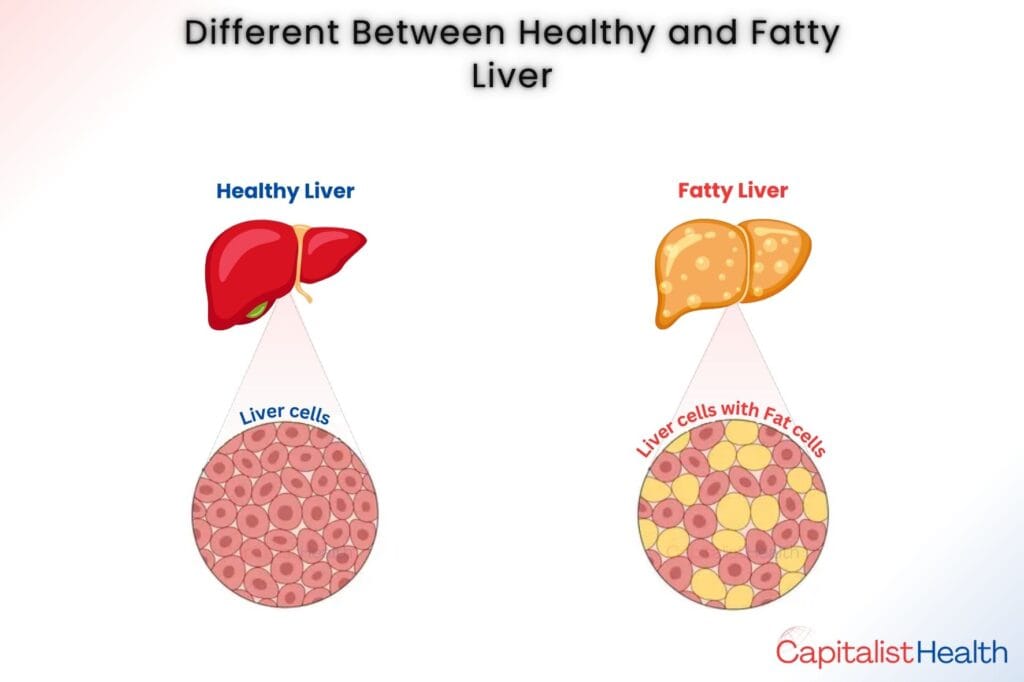
Your liver naturally contains some fat. However, a fatty liver is defined as one that contains more than 5–10% fat. This buildup—mostly triglycerides—interferes with the liver’s ability to function properly.
There are two main types:
🔹 Alcoholic Fatty Liver Disease (AFLD)
Caused by excessive alcohol consumption.
🔹 Non-Alcoholic Fatty Liver Disease (NAFLD)
The more common type in India—is triggered by metabolic dysfunction, not alcohol.
The 4 Stages of Non-Alcoholic Fatty Liver Disease (NAFLD Progression):
🔹Simple Steatosis (Fat accumulation—reversible)
🔹NASH (Non-Alcoholic Steatohepatitis): Inflammation and liver cell damage
🔹Fibrosis: Scarring in liver tissue
🔹Cirrhosis: Damage that can lead to liver failure or cancer which is irreversible
Early Symptoms of Fatty Liver: The Silent Red Flags

Non-Alcoholic Fatty Liver Disease (NAFLD) is often called a “silent epidemic” because it rarely shows symptoms in early stages. However, these subtle signs may indicate liver stress:
🔹 Fatigue (especially after meals)
🔹 Abdominal heaviness in the upper right side
🔹 Brain fog or poor concentration
🔹 Mild weight gain or belly fat
🔹 Elevated liver enzymes
✅ Why it’s dangerous: These symptoms are easy to overlook—and that’s why screening is crucial even if you feel “normal.”
Top Risk Factors for Developing Fatty Liver
Your chances of having fatty liver are significantly higher if you have:
🔹 Overweight or obesity
🔹 Type 2 diabetes
🔹 High cholesterol or triglycerides (dyslipidemia)
🔹 Hypertension (high blood pressure)
🔹 Sedentary lifestyle or poor diet
These conditions can disrupt your metabolic health, making fat more likely to accumulate in your liver.
The Domino Effect: How Your Whole Body Gets Impacted
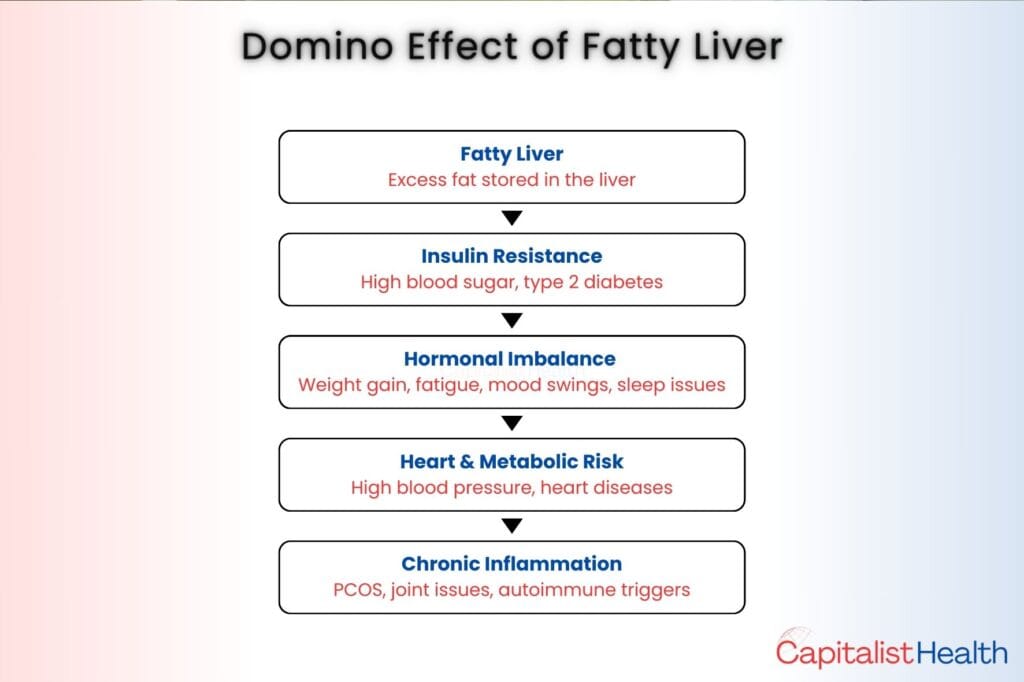
It isn’t just a liver issue—it’s the starting point for major metabolic disorders, When you are diagnosed with fatty liver, it doesn’t just stay confined to your liver it can trigger a chain of other serious health problems that begins to disrupt your entire metabolic system.
This is the main reason diagnosing this condition and reversing it is so important to prevent that entire domino line from falling.
Here’s how it triggers a cascade of health problems:
🔹 Insulin Resistance
Your cells stop responding to insulin, causing high blood sugar and leading to type 2 diabetes.
🔹 Obesity & Visceral Fat
Fat accumulates around organs, raising your risk of heart disease and hypertension.
🔹 Chronic Inflammation
Fatty liver releases inflammatory markers that worsen joint pain, PCOS, and autoimmune conditions.
🔹 Hormonal Imbalances
Your liver helps regulate estrogen, cortisol, and thyroid hormones. A fatty liver disrupts these processes—leading to fatigue, mood changes, and poor sleep.
Can Fatty Liver Be Reversed?
Fortunately, there is a way to reverse fatty liver. Despite being a regenerative organ, the human liver requires lifestyle changes and early intervention.
According to research, losing just 7–10% of your body weight can:
✔ Reduce liver fat
✔ Improve insulin sensitivity
✔ Decrease inflammation
✔ Restore liver function
💡 Reminder: Only if you make a change in your behaviours early on will the liver be able to regenerate.
Why Indians Are More Vulnerable to Fatty Liver?

🔹 High-Carb, Low-Protein Diets
The average Indian diet is rich in refined carbs (white rice, roti, sugar) but low in quality protein—essential for liver repair.
🔹 Sedentary Urban Lifestyles
Long commutes, desk jobs, and digital entertainment have reduced physical activity.
🔹 Genetic Insulin Resistance
Many Indians develop abdominal fat and metabolic issues even at lower body weights.
🔹 India: The Diabetes Capital
With the world’s highest type 2 diabetes rates, it’s no surprise NAFLD is rising too.
How to Prevent or Reverse Fatty Liver
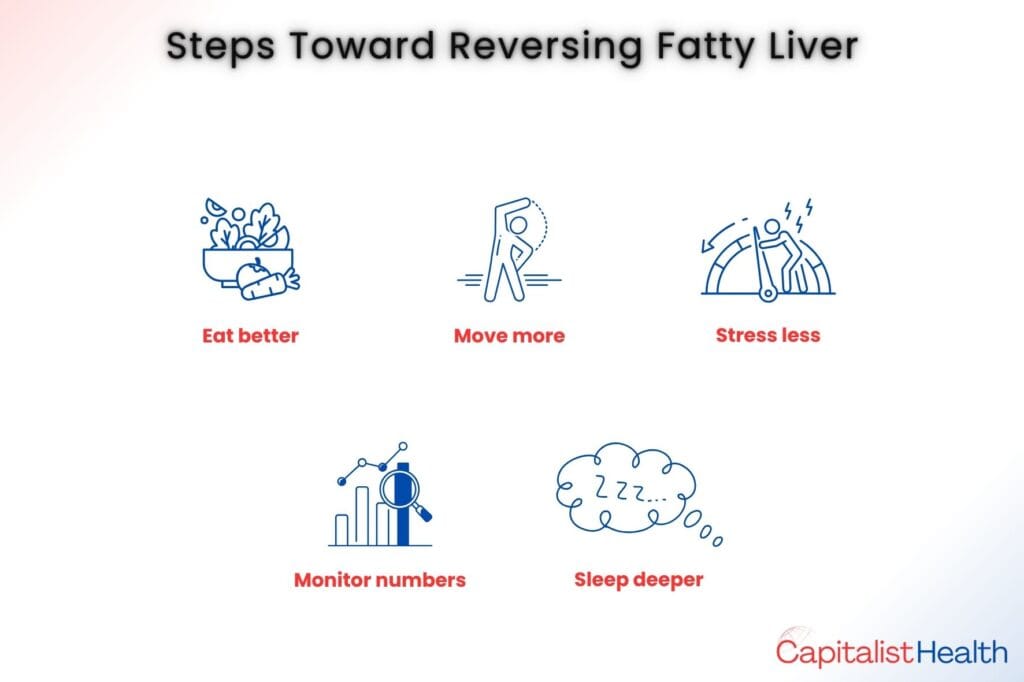
🔹 Move Daily — Your Liver Loves It:
30–45 Minutes of Structured Exercise (5x/week)
➡ Brisk walking, yoga, cycling, dancing, or strength training
➡ Choose activities you enjoy — consistency matters more than intensity
NEAT (Non-Exercise Activity Thermogenesis)
✅ Stand while working
✅ Do chores
✅ Walk while taking phone calls
💡 Movement = Metabolism. You don’t need a gym—just stop sitting for 10 hours straight.
🔹 Eat to Heal Your Liver:
✅ Balanced nutrition: Lean proteins, vegetables, whole grains, and healthy fats make up a balanced diet
✅ Focus on Protein: For every meal, include tofu, paneer, dals, eggs, fish, or chicken
✅ Reduce Refined Sugars and Processed Carbs: Replace white flour and sweets with fruits and whole foods
✅ Mindful Caloric Intake: Consume foods high in nutrients that fill you up without going overboard.providing satisfaction without excessive calories
🔹 Prioritize Sleep & Manage Stress:
Your liver regenerates during deep, uninterrupted sleep, and chronic stress can promote fat storage via elevated cortisol.
✅ Sleep Tips:
Target 7–8 hours/night
Avoid screens 1 hour before bed
Create a calming wind-down routine (stretching, reading, herbal tea)
✅ Stress Management:
Yoga or pranayama (10–15 mins/day)
Meditation or journaling
Spend time with loved ones or in nature.
🔹 Monitor Your Health: What Gets Tracked, Gets Fixed
Don’t wait for symptoms—track your health proactively.
✅ Liver Function Tests (LFTs)
Elevated liver enzymes may indicate liver stress or inflammation.
✅ Lipid Profile + Fasting Insulin
Checks for cholesterol, triglycerides, and insulin resistance—key fatty liver indicators.
✅ Body Fat % vs. Weight
BMI can lie. Visceral fat (fat around your organs) is the real threat—even in “thin” individuals.
💡 Make use of a waist-to-hip ratio calculator a smart scale. Pay attention to your lean body composition rather than just your weight.
The Prevention Formulae: Awareness = Prevention = Reversal
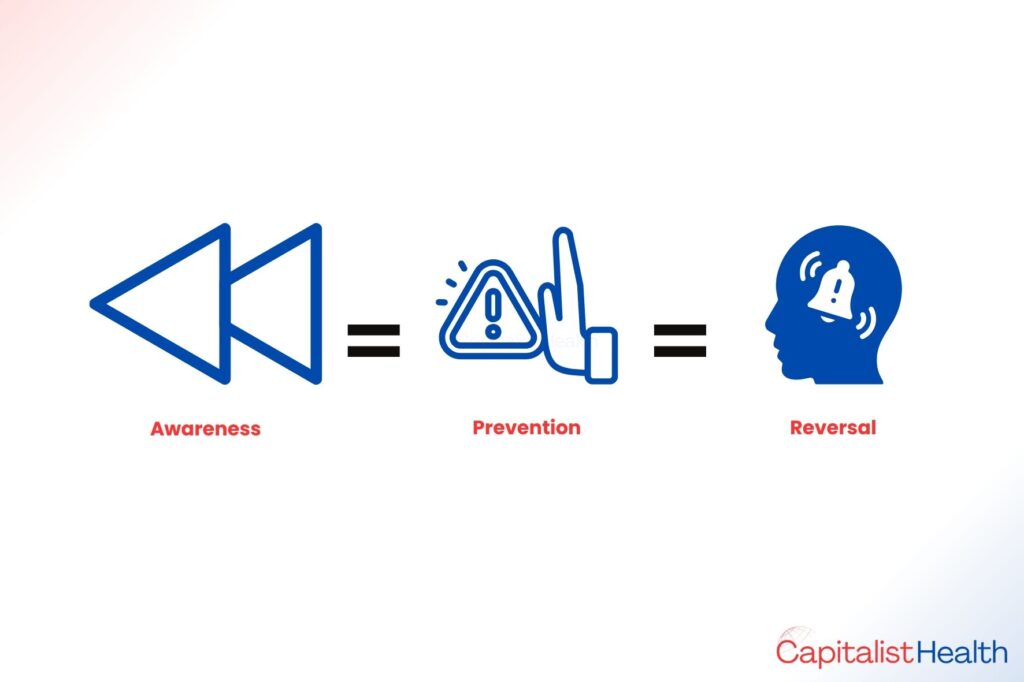
Fatty liver is one of the most underdiagnosed, yet fully reversible conditions today.
The solution isn’t a pill or a detox it’s daily action:
🔹 Eat smarter
🔹 Move regularly
🔹 Sleep deeper
🔹 Stress less
🔹 Monitor your numbers
Small, intentional changes = big results over time.
Your liver is fighting for you—it’s time to fight for it.
👉 If you found this article informative and want to explore how to understand and manage diabetes effectively, don’t miss our in-depth guide on the topic.
Click here to read the full article on diabetes management.

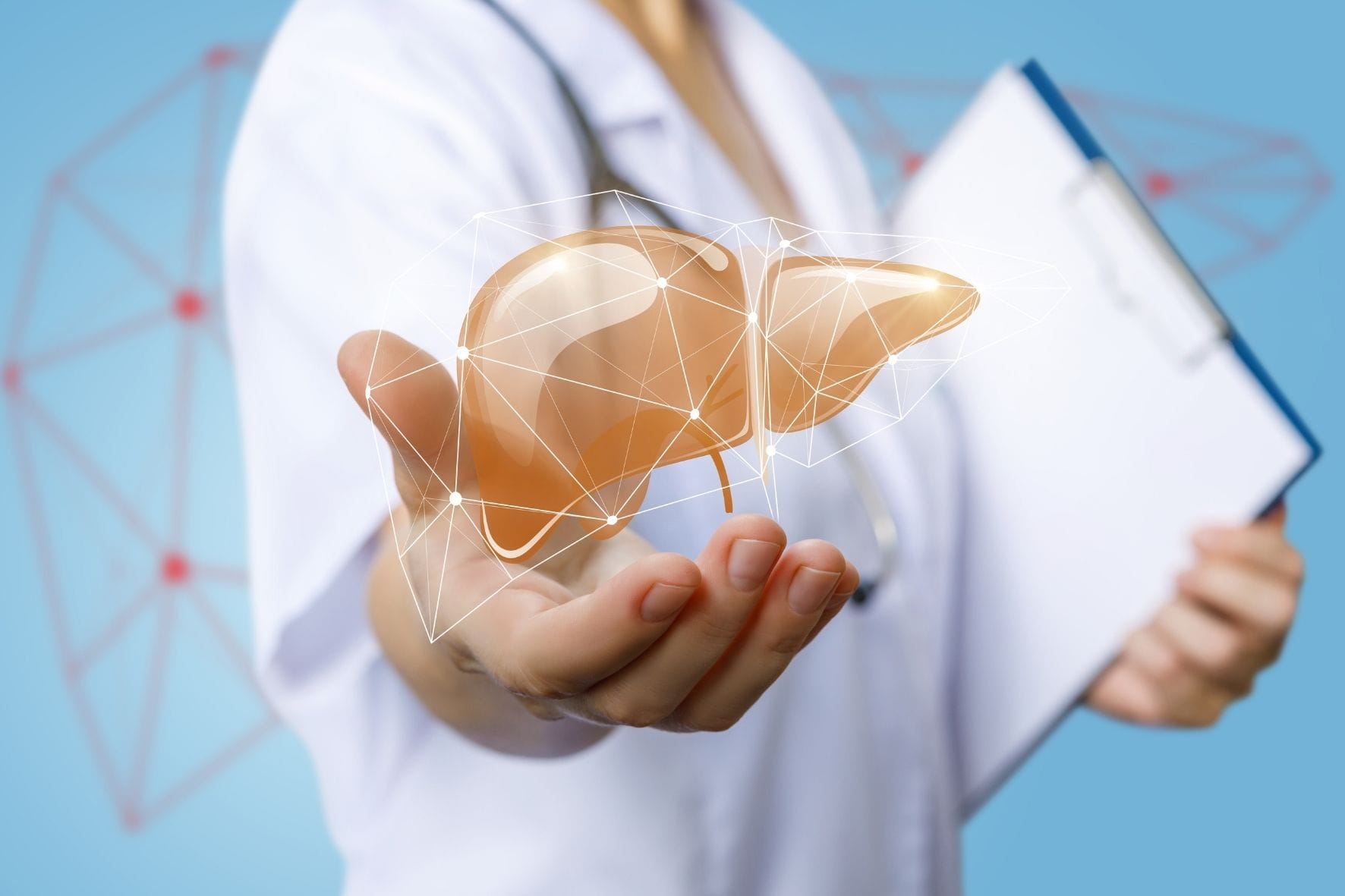


1 Comment
Your comment is awaiting moderation.
В нашей компании дома деревянные под ключ реализуются с акцентом на надёжность, энергоэффективность и индивидуальные архитектурные решения.
Деревянные дома под ключ становятся все более популярными среди владельцев загородной недвижимости. Деревянные дома очаровывают своим естественным видом и экологическими свойствами.
Главное преимущество деревянных домов заключается в быстроте их строительства. Современные технологии позволяют возводить такие здания в кратчайшие сроки.
Деревянные дома славятся хорошей теплоизоляцией. Зимой в них тепло, а летом они остаются прохладными.
Обслуживание деревянных домов не вызывает особых трудностей и не требует значительных усилий. Периодическая обработка древесины защитными составами значительно увеличивает долговечность дома.
Your comment is awaiting moderation.
Quick update notifications included in Aviator game download.
Your comment is awaiting moderation.
what to pack for Australia tour what to pack for Australia tour .
Your comment is awaiting moderation.
Casino mirror links are vital for seamless user access.
Your comment is awaiting moderation.
Освободите себя от утомительной уборки, выбрав заказать клининг в Москве с гарантией качества. Современный подход и индивидуальное внимание — в каждом заказе.
Услуги клининга в Москве набирают популярность, и это не случайно. С каждым годом все больше людей осознают важность чистоты в своем доме и на рабочем месте.
Клининговые компании предлагают широкий спектр услуг, включая уборку квартир, офисов и специализированные услуги. Сравнивая различные клининговые агентства, можно выделить несколько ключевых факторов, которые стоит учитывать при выборе.
Профессиональная уборка подразумевает использование специализированного оборудования и качественных чистящих средств. Специалисты клининговых компаний проходят обучение, что позволяет им успешно справляться с любыми задачами по уборке.
В Москве стоимость клининговых услуг зависит от множества факторов, включая размер помещения и требования клиента. Прежде чем принимать решение, стоит ознакомиться с отзывами о различных клининговых компаниях и оценить их предложения.
услуги клининга https://kliningovaya-kompaniya-1.ru/
Your comment is awaiting moderation.
Step into Lucky Jet and test your skills.
Your comment is awaiting moderation.
Ищете лучшие условия? Надежно снять жилье в Архипо-Осиповке без переплат просто с нашим прозрачным сервисом бронирования.
Архипо-Осиповка — это замечательный курорт на побережье Черного моря. Местные пляжи, теплые воды и красивые виды делают этот курорт идеальным для семейного отдыха и молодежных путешествий.
Здесь можно найти разнообразные варианты жилья. От современных гостиниц до традиционных частных домов — туристы найдут здесь подходящее жилье на любой вкус.
На курорте можно не только наслаждаться морем, но и исследовать его окрестности. Посетить местные водопады, горные озера и экскурсии по заповедникам стоит каждому туристу.
Не забудьте попробовать различные блюда местной кухни в Архипо-Осиповке. Местные заведения порадуют разнообразием меню из морепродуктов и других вкусностей.
отдых в архипо осиповке 2025 цены https://otdyh-arhipo-osipovka1.ru/
Your comment is awaiting moderation.
Заказать флис оптом москва у проверенного поставщика — оптимальное решение для тех, кто ценит качество и оперативность.
Флис — это отличный материал для одежды в холодное время года. Флис известен своей легкостью и способностью сохранять тепло, что делает его востребованным. Благодаря своим характеристикам, флис становится выбором для многих, кто увлекается активным отдыхом. Изделия из флиса, такие как кофты и куртки, эффективно удерживают тепло и обладают быстрым временем высыхания.
При выборе флиса стоит обратить внимание на качество материала. Флис низкого качества может быстро утратить свои теплозащитные характеристики. Оптимальным выбором будут изделия от надежных брендов, обеспечивающих высокое качество. Таким образом, вы минимизируете риск неприятных сюрпризов при использовании.
Флис можно использовать не только для верхней одежды, но и для аксессуаров. Флисовые шапки, перчатки и шарфы станут прекрасным дополнением к вашему зимнему гардеробу. Флисовые аксессуары добавят тепла и уюта в холодные зимние дни. Не забывайте о возможности дополнить свой зимний гардероб флисовыми аксессуарами.
В заключение можно сказать, что флис — это незаменимый материал для любого зимнего гардероба. Он сочетает в себе тепло, легкость и практичность, что делает его идеальным выбором. Также помните о разнообразии флисовых изделий, от верхней одежды до аксессуаров. В конечном итоге, приобретение флиса точно оправдает ваши ожидания.
купить флис оптом https://www.flis-optom.ru
Your comment is awaiting moderation.
Когда обычной уборки недостаточно, поможет ген уборка квартиры — тщательная, точная и эффективная работа по всем стандартам.
Процесс генеральной уборки является ключевым для создания комфортной и уютной атмосферы в вашем доме. Мы все знаем, как иногда важно сделать генеральную уборку в своих жилищах.
Прежде всего, необходимо решить, какие комнаты требуют более тщательной уборки. Сначала можно выбрать ту комнату, которая требует наибольшего внимания.
После выбора помещения следует подготовить необходимые инструменты и средства для уборки. Подготовьте чистящие порошки, губки и ведра — так вы будете готовы к убиранию.
Важно разработать план уборки, чтобы не упустить ни одну деталь. Обратите внимание на все труднодоступные места, это поможет сделать уборку более качественной.
Your comment is awaiting moderation.
Casino mirror guarantees access even during bans
Your comment is awaiting moderation.
Если вы индивидуальный предприниматель, воспользуйтесь лизингом коммерческих автомобилей для ип для обновления автопарка. Это просто, выгодно и эффективно.
Лизинг коммерческого транспорта — это отличная возможность для бизнеса. Лизинг дает возможность пользоваться новыми автомобилями, не тратя много средств upfront.
При этом, лизинг требует минимальных затрат на обслуживание. Это дает возможность бизнесу сосредоточиться на своих целях, а не на ремонте транспортных средств.
Важно подобрать оптимальные условия договора лизинга для комфортного использования транспорта. Разные лизинговые компании предоставляют возможность выбора сроков договора и размеров ежемесячных взносов.
Важно также учитывать налоговые преимущества лизинга. Многие предприятия могут списывать платежи по лизингу как расходы, что снижает налоговую нагрузку.
Your comment is awaiting moderation.
Если вы ищете нестандартный формат досуга, яхты аренда — это удобное решение, сочетающее в себе уют и природную красоту.
Сдача в аренду яхты предоставляет уникальную возможность насладиться морскими путешествиями. Можно выбрать по своему вкусу: от яхт с высокой скоростью до комфортных катеров.
Прежде чем взять яхту в аренду, стоит внимательно рассмотреть варианты. Разные компании могут предоставить разные условия аренды, в том числе стоимость и дополнительные опции.
Обязательно проверьте все условия, прежде чем заключать контракт. Следует узнать, что входит в стоимость аренды, а что является дополнительной платой.
Сдача в аренду яхты может стать уникальным опытом и основой для незабываемых историй. Неважно, планируете ли вы спонтанный отдых или заранее запланированное мероприятие, яхта будет прекрасным местом.
Your comment is awaiting moderation.
Если вам нужна глубокая очистка всех поверхностей, профессиональная генеральная уборка квартиры поможет быстро привести жильё в идеальное состояние.
Генеральная уборка является существенное событие для в жизни любой семьи. Такой процесс способствует обеспечивать порядок и свежесть в жилом пространстве.
Для успешной генеральной уборки необходимо составить план. Начните с того, чтобы определить, какие помещения требуют внимания. Такой подход позволит избежать хаоса.
Кроме того, важно подготовить необходимые средства. Необходимыми инструментами будут чистящие средства, пылесос и тряпки. Хорошая подготовка позволит сэкономить время.
Когда все готово, можно начинать уборку. Убирайте по одной комнате, чтобы избежать путаницы. Так будет легче увидеть результаты своих трудов.
Your comment is awaiting moderation.
Сделайте морскую прогулку особенной — снять яхту сочи можно на удобное для вас время с возможностью индивидуального маршрута.
Прокат яхты — замечательный способ насладиться морскими приключениями. Все больше людей предпочитают проводить отпуск на яхте.
Процесс проката яхты может вызвать некоторые трудности. Но при наличии информации, все станет намного проще.
Первым делом, вам необходимо определиться с маршрутом. От выбранного маршрута часто зависит, какую яхту стоит арендовать.
Не упустите из виду условия договора аренды яхты. Знание условий аренды спасет вас от неожиданных затрат.
One of the need of the time topic and an informative blog. Keep up the good work.